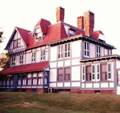
Stick Style (1860s – 1890s)
Stick Style Victorian houses have exposed trusses, “stickwork,” and other details borrowed from medieval times.
History:
The most important features of Stick Style houses are on the exterior wall surfaces, which are ornamented with “stickwork,” or decorative half-timbering. The house also has brackets, rafters, and braces. These details are not necessary structurally. They are decorations that imitated architecture from the medieval past. Instead of three-dimensional ornamentation, the emphasis is on patterns and lines. Because the decorative details are flat, they are often lost when homeowners remodel. If the decorative stickwork is covered up with vinyl siding or painted a single solid color, a Stick Style Victorian may appear plain and rather ordinary.
The Palliser Company, which published many plan books during the Victorian era, called stick architecture plain yet neat, modern, and comfortable. However, Stick was a short-lived fashion. The angular and austere style couldn’t compete with the fancy Queen Annes that took America by storm. Some Stick architecture did dress up in fancy Eastlake spindles and Queen Anne flourishes. But very few authentic Stick Style homes remain intact.
On first glance, you might confuse Stick houses with the later Tudor Revival Style. However, most Tudor Revival houses are sided with stucco, stone, or brick. Stick Style houses are almost always made with wood.
Features:
Rectangular shape
Wood siding
Steep, gabled roof
Overhanging eaves
Ornamental trusses (gable braces)
Decorative braces and brackets
Decorative half-timbering
Next: Shotgun Style